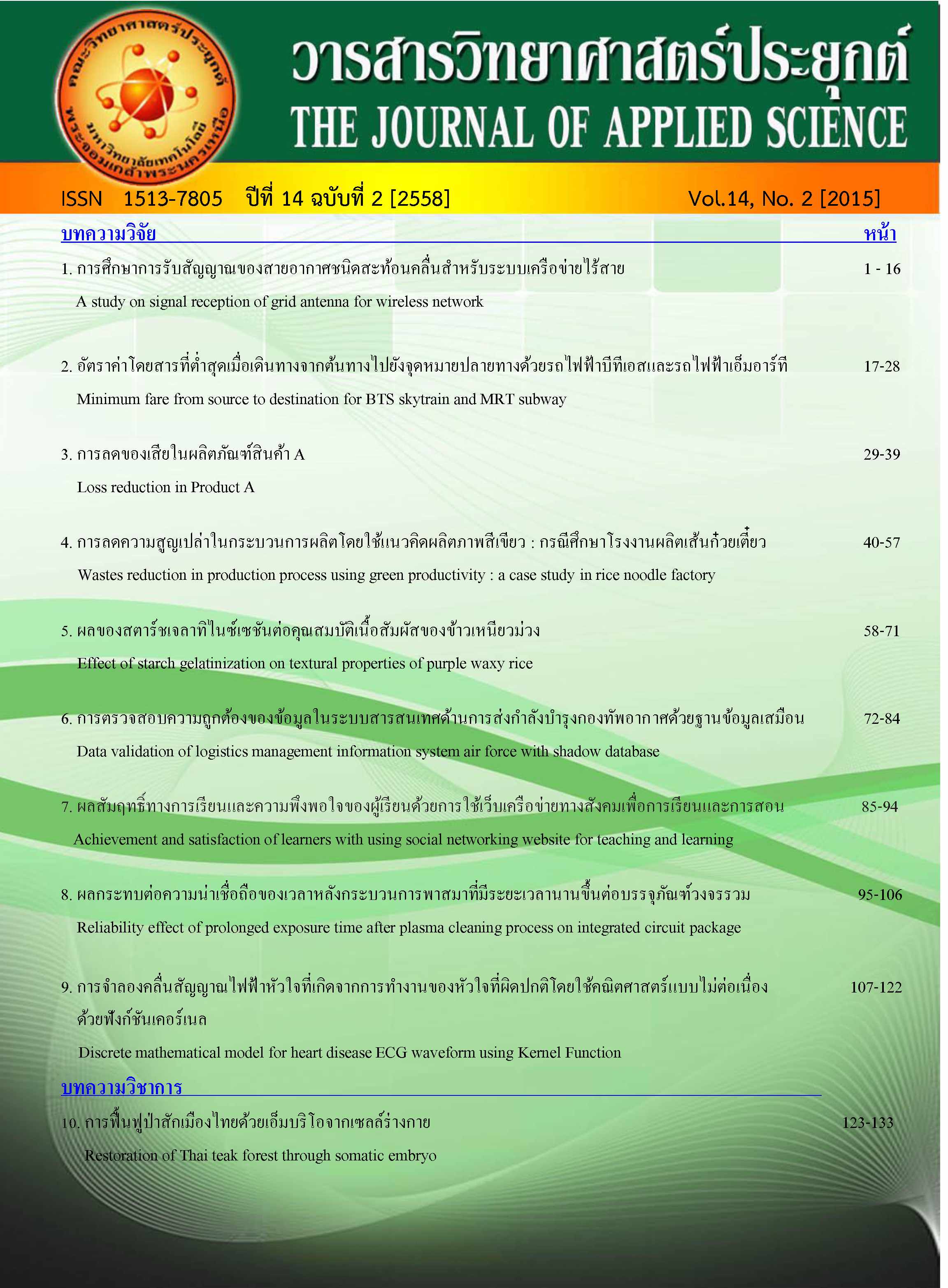การศึกษาการรับสัญญาณของสายอากาศชนิดสะท้อนคลื่นสำหรับ ระบบเครือข่ายไร้สาย
คำสำคัญ:
สายอากาศของเครือข่ายแลนไร้สาย, ค่าความเข้มของสัญญาณบทคัดย่อ
เทคโนโลยีเครือข่าย LAN แบบไร้สาย หรือ WLAN (wireless LAN) กำลังได้รับความนิยมเป็นอย่างมาก เนื่องจากสามารถสร้างความสะดวกและอิสระในการใช้งาน ซึ่งเทคโนโลยี WLAN นี้ทำให้การเชื่อมต่ออุปกรณ์ คอมพิวเตอร์ภายในบ้านหรือสำนักงานเข้าด้วยกันโดยไม่จำเป็นที่จะต้องใช้สายนำสัญญาณให้ยุ่งยาก อุปกรณ์ คอมพิวเตอร์ทั้งแบบตั้งโต๊ะและแบบพกพาสามารถเชื่อมต่อถึงกันหรือเชื่อมต่อเข้ากับเครือข่ายจากบริเวณที่อยู่ใน รัศมีของสัญญาณได้อย่างอิสระ เนื่องจากสัญญาณข้อมูลของระบบเครือข่าย LAN แบบไร้สายแพร่กระจายอยู่ใน อากาศ และไม่จำกัดขอบเขตอยู่เพียงแต่ในห้องๆ เดียวหรือบริเวณแคบๆ เท่านั้น ปัจจุบันการเชื่อมโยงระหว่าง เครือข่ายคอมพิวเตอร์ที่อยู่พื้นที่ห่างไกลกัน โดยวิธีการขยายขอบเขตด้วย wireless bridge นั้นเป็นการขยายพื้นที่ใน การให้บริการทางเครือข่าย เนื่องจากในบางพื้นที่ผู้ด้องการใช้บริการเครือข่ายที่ไม่สามารถใช้บริการได้ ซึ่งจำเป็นต้องใช้ระบบ wireless bridge เพื่อช่วยในการเชื่อมต่อและขยายพื้นที่เชื่อมต่อในการให้บริการเครือข่าย LAN ผู้วิจัยเล็งเห็นถึงความสำคัญในเรื่องนี้จึงได้ทำการวิเคราะห์ทดสอบประสิทธิภาพและพัฒนาคุณภาพของสายอากาศ เครือข่าย LAN แบบไร้สาย ให้มีประสิทธิรูปที่ดีขึ้นและสามารถรับ-ส่งสัญญาณด้วยระยะทางและการกระจาย สัญญาณที่ดี โดยเลือกใช้วัสดุอุปกรณ์ในการจัดทำที่มีราคาถูกและเหมาะสมกับประเภทการใช้งานเพื่อตอบสนองผู้ใช้งานเครือข่ายได้อย่างมีเสถียรภาพมากขึ้นด้วยค่าใช้จ่ายที่น้อยลง โดยจากผลการทดลองสามารถสรุปได้ว่าวัสดุที่แตกต่างกันของหน้าจาน มีผลต่อประสิทธิภาพของสายอากาศเป็นอย่างมาก ทั้งด้านค่าความเข้มสัญญาณและระยะทางในการรับ-ส่งสัญญาณ จากนั้นผู้วิจัยจึงสามารถสรุปได้ว่าคุณภาพของจานสัญญาณเป็นไปตามสภาพนำ ไฟฟ้าของวัสดุหน้าจาน คือจานที่ใช้วัสดุหน้าจานเป็นฟรอยด์อะลูมีเนียมจะให้คุณภาพสัญญาณได้ดีกว่าจานที่ใช้ หน้าจานสังกะสีและผ้าฝ้ายตามลำดับ


